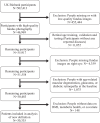Associations of Metabolically Healthy Obesity and Retinal Age Gap
- PMID: 39570618
- PMCID: PMC11585067
- DOI: 10.1167/tvst.13.11.26
Associations of Metabolically Healthy Obesity and Retinal Age Gap
Abstract
Purpose: We investigated the association between metabolically healthy obesity (MHO) and retinal age gap and explored potential sex differences in this association.
Methods: This study included 30,335 participants from the UK Biobank. Body mass index (BMI) was classified into normal weight, overweight, and obesity. Metabolic health (MH) was defined as meeting the following criteria: systolic blood pressure of <130 mm Hg, no antihypertensive drugs, waist-to-hip ratio of <0.95 for women or 1.03 for men, and the absence of diabetes. Participants were categorized as MH normal weight (MHN), MH overweight (MHOW), MHO, metabolically unhealthy normal weight, metabolically unhealthy (MU) overweight, and MU obesity. Retinal age gap was defined as the difference between retinal age and chronological age. Linear regression models were used to investigate the association of metabolic phenotypes of obesity with retinal age gap.
Results: Compared with MHN, individuals with MHOW (β, 0.17; 95% confidence interval [CI], 0.01-0.32; P = 0.039) and MHO (β, 0.23; 95% CI, 0.02-0.44; P = 0.031) were associated with increased retinal age gap. Furthermore, individuals classified as metabolic unhealthy were also associated with higher retinal age gap, irrespective of body mass index categories (β for MU normal weight, 0.23; 95% CI, 0.08-0.38; P = 0.003; β for MU overweight: 0.31; 95% CI, 0.18-0.45; P < 0.001; β for MU obesity, 0.50; 95% CI, 0.36-0.65; P < 0.001). No significant sex difference was observed in the association between metabolic phenotypes of obesity and retinal age gap (all P for interaction > 0.05).
Conclusions: MHOW and MHO were associated significantly with an increased retinal age gap compared with MHN individuals. Weight management should be recommended for individuals who are overweight or obese, even in the absence of metabolic unhealth.
Translational relevance: Retinal age gap provides a simple tool for identifying early health risks for MHOW and MHO individuals.
Conflict of interest statement
Disclosure:
Figures
Similar articles
-
[Association between obesity and the risk of microvascular complications in Yinzhou District, Ningbo adults with type 2 diabetes mellitus].Wei Sheng Yan Jiu. 2025 Jul;54(4):608-620. doi: 10.19813/j.cnki.weishengyanjiu.2025.04.012. Wei Sheng Yan Jiu. 2025. PMID: 40695761 Chinese.
-
Amino Acid Associations in Healthy and Unhealthy Obesity.J Nutr. 2025 Aug;155(8):2643-2652. doi: 10.1016/j.tjnut.2025.04.037. Epub 2025 May 27. J Nutr. 2025. PMID: 40441382 Free PMC article.
-
Metformin for women who are overweight or obese during pregnancy for improving maternal and infant outcomes.Cochrane Database Syst Rev. 2018 Jul 24;7(7):CD010564. doi: 10.1002/14651858.CD010564.pub2. Cochrane Database Syst Rev. 2018. PMID: 30039871 Free PMC article.
-
Long-term weight change and transition of metabolic health status in middle life and the risk of atrial fibrillation.Heart Rhythm. 2025 Aug;22(8):e285-e293. doi: 10.1016/j.hrthm.2025.03.1942. Epub 2025 Mar 13. Heart Rhythm. 2025. PMID: 40089048
-
Gut microbiome-based interventions for the management of obesity in children and adolescents aged up to 19 years.Cochrane Database Syst Rev. 2025 Jul 10;7(7):CD015875. doi: 10.1002/14651858.CD015875. Cochrane Database Syst Rev. 2025. PMID: 40637175 Review.
References
-
- WHO Consultation on Obesity (1999: Geneva, Switzerland) & World Health Organization. Obesity: preventing and managing the global epidemic. Report of a WHO consultation. World Health Organ Tech Rep Ser. 2000; 894: i–xii, 1–253. - PubMed
Publication types
MeSH terms
LinkOut - more resources
Full Text Sources
Research Materials
Miscellaneous


